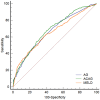Relationship between anion gap and in-hospital mortality in intensive care patients with liver failure: a retrospective propensity score matching analysis
- PMID: 38322565
- PMCID: PMC10839379
- DOI: 10.62347/UVCX1997
Relationship between anion gap and in-hospital mortality in intensive care patients with liver failure: a retrospective propensity score matching analysis
Abstract
Objectives: To elucidate the association between anion gap (AG) and in-hospital mortality in intensive care patients with liver failure.
Methods: Demographic and clinical characteristics of intensive care patients with liver failure in the Medical Information Mart for Intensive Care-IV (MIMIC-IV) database were collected, and binomial logistic and Cox regression was conducted to investigate the association between AG and in-hospital mortality. The area under the receiver operating characteristic (ROC) curve (AUC) was conducted to characterize the performance of AG in predicting in-hospital mortality, and was compared with the albumin corrected anion gap (ACAG) and the End-Stage Liver Disease (MELD) score. The Kaplan-Meier curve was plotted for in-hospital survival analysis of AG and patients with liver failure. The propensity score matching (PSM) analysis was performed to mitigate selection bias.
Results: AG was an independent risk factor for in-hospital mortality in intensive care patients with liver failure. Before PSM, the AUCs of AG, ACAG, and MELD were 0.666, 0.682, and 0.653, respectively. After PSM, the AUCs of AG, ACAG, and MELD scores were 0.645, 0.657, and 0.645, respectively, and there is no difference in the predictive performance of the three indicators upon comparison. Compared with the low-AG (≤20 mmol/L) group, the hazard ratio (HR) for in-hospital death of the high-AG (>20 mmol/L) group was determined to be 2.1472 (before PSM)/1.8890 (after PSM).
Conclusions: AG is associated with in-hospital mortality in intensive care patients with liver failure and demonstrates a moderate predictive value, which is comparable to the predictive power of the MELD score. AG may serve as an indirect marker of in-hospital mortality of patients with liver failure by reflecting the degree of metabolic acidosis.
Keywords: Anion gap; MIMIC-IV; in-hospital mortality; liver failure; propensity score matching.
AJTR Copyright © 2024.
Conflict of interest statement
None.
Figures





Similar articles
-
Albumin corrected anion gap for predicting in-hospital mortality among intensive care patients with sepsis: A retrospective propensity score matching analysis.Clin Chim Acta. 2021 Oct;521:272-277. doi: 10.1016/j.cca.2021.07.021. Epub 2021 Jul 23. Clin Chim Acta. 2021. PMID: 34303712
-
The correlation between albumin-corrected anion gap and prognosis in patients with acute myocardial infarction.ESC Heart Fail. 2024 Apr;11(2):826-836. doi: 10.1002/ehf2.14639. Epub 2024 Jan 2. ESC Heart Fail. 2024. PMID: 38164072 Free PMC article.
-
Elevated albumin corrected anion gap is associated with poor in-hospital prognosis in patients with cardiac arrest: A retrospective study based on MIMIC-IV database.Front Cardiovasc Med. 2023 Mar 23;10:1099003. doi: 10.3389/fcvm.2023.1099003. eCollection 2023. Front Cardiovasc Med. 2023. PMID: 37034339 Free PMC article.
-
Association between albumin-corrected anion gap and in-hospital mortality of intensive care patients with trauma: A retrospective study based on MIMIC-Ⅲ and Ⅳ databases.PLoS One. 2024 Mar 7;19(3):e0300012. doi: 10.1371/journal.pone.0300012. eCollection 2024. PLoS One. 2024. PMID: 38452113 Free PMC article.
-
Association of serum anion gap and risk of long-term mortality in patients following coronary artery bypass grafting: A propensity score matching study.J Card Surg. 2022 Dec;37(12):4906-4918. doi: 10.1111/jocs.17167. Epub 2022 Nov 15. J Card Surg. 2022. PMID: 36378900
Cited by
-
Association of albumin-corrected anion gap with severe consciousness disorders and outcomes in ischemic stroke: a retrospective MIMIC analysis.Sci Rep. 2024 Oct 29;14(1):26006. doi: 10.1038/s41598-024-76324-x. Sci Rep. 2024. PMID: 39472602 Free PMC article.
-
Anion gap predicting 90-Day mortality and guiding furosemide use in ARDS.Sci Rep. 2025 Feb 10;15(1):4954. doi: 10.1038/s41598-025-89163-1. Sci Rep. 2025. PMID: 39930113 Free PMC article.
References
-
- Liver Failure and Artificial Liver Group, Chinese Society of Infectious Diseases, Chinese Medical Association; Severe Liver Disease and Artificial Liver Group, Chinese Society of Hepatology, Chinese Medical Association. Guideline for diagnosis and treatment of liver failure. Zhonghua Gan Zang Bing Za Zhi. 2019;27:18–26. - PubMed
-
- Bernuau J, Rueff B, Benhamou JP. Fulminant and subfulminant liver failure: definitions and causes. Semin Liver Dis. 1986;6:97–106. - PubMed
-
- Kamath PS, Wiesner RH, Malinchoc M, Kremers W, Therneau TM, Kosberg CL, D’Amico G, Dickson ER, Kim WR. A model to predict survival in patients with end-stage liver disease. Hepatology. 2001;33:464–470. - PubMed
-
- Batra Y, Acharya SK. Acute liver failure: prognostic markers. Indian J Gastroenterol. 2003;22(Suppl 2):S66–68. - PubMed
-
- Peláez-Luna M, Martinez-Salgado J, Olivera-Martinez MA. Utility of the MAYO End-Stage Liver Disease score, King’s College Criteria, and a new in-hospital mortality score in the prognosis of in-hospital mortality in acute liver failure. Transplant Proc. 2006;38:927–929. - PubMed
LinkOut - more resources
Full Text Sources
Miscellaneous
